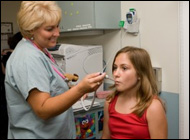H1N1 Flu: Are Parents Underestimating Risk to Kids?
With schools back in session, H1N1 flu has become more active across the United States—especially among children. A new vaccine against H1N1 flu—strongly recommended for kids—has been tested and is expected to be available in October. But will parents get their children vaccinated?
The latest C.S. Mott Children’s Hospital National Poll on Children’s Health finds only 40 percent of parents indicate they will get their children vaccinated against H1N1 flu—while 54 percent of parents indicate they will get their children vaccinated against seasonal flu. Among parents who do not plan to get their children vaccinated against H1N1 flu, 46 percent indicate they are not worried about their children getting H1N1 flu, while 20 percent believe H1N1 flu is not serious.
“This information about parents’ plans to vaccinate their kids against H1N1 flu suggests that parents are much less concerned about H1N1 flu than seasonal flu for their kids. That perception may not match the actual risks,” says Matthew Davis, M.D., director of the poll and associate professor of pediatrics and internal medicine in the Child Health Evaluation and Research Unit at the University of Michigan Medical School.
The poll also shows vaccination plans for H1N1 flu differs by racial/ethnic groups. More than half of Hispanic parents plan to have their children vaccinated against H1N1 flu, compared to only 38 percent of white parents and 30 percent of black parents.
Vaccination plans of Hispanic parents may reflect a higher perceived risk in the Hispanic community, given the well publicized outbreak of H1N1 flu in Mexico in early 2009, Davis says.
 In describing their perceived risk of H1N1 flu for children, one-third of parents indicate they believe H1N1 flu will be worse than seasonal flu. Nearly half of parents believe H1N1 and seasonal flu will be about the same for children, according to the poll.
In describing their perceived risk of H1N1 flu for children, one-third of parents indicate they believe H1N1 flu will be worse than seasonal flu. Nearly half of parents believe H1N1 and seasonal flu will be about the same for children, according to the poll.
These perceptions contrast information from the CDC suggesting that—unlike what is typically seen with seasonal flu—rates of illness and hospitalizations related to H1N1 flu are higher for children than for other age groups.
“It can be difficult to follow all the new information about a fast moving target like H1N1 flu,” says Davis, who is also associate professor of public policy at the U-M Gerald R. Ford School of Public Policy. “Health care professionals and public health officials need to help parents and the community at-large understand that children are one of the groups at greatest risk for getting H1N1, and for getting very sick from the disease as well.”
Among parents who do not plan to get their children vaccinated against H1N1 flu, or who are unsure, about half are worried about possible side effects of the vaccine. Among parents who do plan to get their children vaccinated against H1N1 flu, about 4 in 5 believe that H1N1 is a serious disease and worry about their children getting H1N1 illness. Parents who think H1N1 flu will be worse for children than seasonal flu were much more likely to plan to have their children vaccinated against H1N1 flu.
“This connection between perceived risk and plans to vaccinate against H1N1 flu makes a lot of sense,” says Davis. “What it emphasizes is that to reach parents who are currently unsure about H1N1 vaccination and convince them to go ahead and vaccinate their kids, the health care community needs to focus on communicating key information about the risk of H1N1 flu for children.”
The poll surveyed 1,678 parents from Aug. 13 - 31, 2009 across the U.S. about their plans and perceptions related to getting their children vaccinated against H1N1 flu and seasonal flu.
FULL REPORT: http://www.med.umich.edu/mott/npch/pdf/092409report.pdf
FIGURES: http://www.med.umich.edu/mott/npch/pdf/092409figures.pdf
POLL QUESTIONS: http://www.med.umich.edu/mott/npch/pdf/092409questions.pdf
Resources for parents from the Centers for Disease Control and Prevention:
General information about H1N1 influenza: http://www.cdc.gov/h1n1flu/qa.htm
Information about the H1N1 vaccine and vaccine safety: http://cdc.gov/h1n1flu/vaccination/vaccine_safety_qa.htm
Methodology: This report presents findings from a nationally representative household survey conducted exclusively by Knowledge Networks, Inc, for C.S. Mott Children’s Hospital via a method used in many published studies. The survey was administered in August 2009 to a randomly selected, stratified group of parents aged 18 and older (n=1,678) from the Knowledge Networks standing panel that closely resembles the U.S. population. The sample was subsequently weighted to reflect population figures from the Census Bureau. The survey completion rate was 62 percent among panel members contacted to participate. The margin of error is plus or minus 2 to 5 percentage points for the main analysis. For results based on subgroups, the margin of error is higher.
To learn more about Knowledge Networks, visit http://www.knowledgenetworks.com.
Purpose/Funding: The C.S. Mott Children’s Hospital National Poll on Children’s Health – funded by the Department of Pediatrics and Communicable Diseases and part of the CHEAR Unit at the U-M Health System – is designed to measure major health care issues and trends for U.S. children and their families. For this particular topic, additional funding was provided by the Centers for Disease Control and Prevention.
Source: University of Michigan Health System